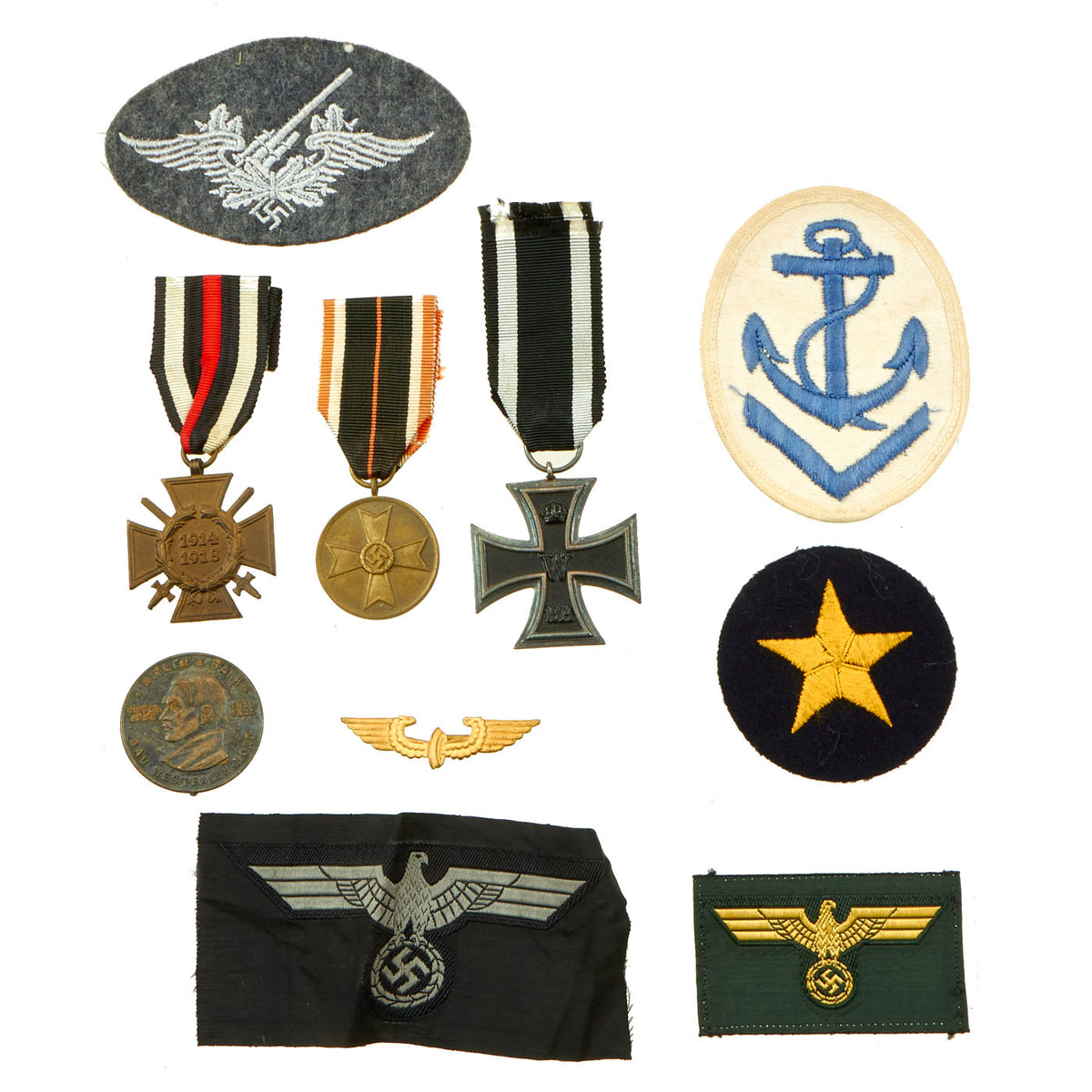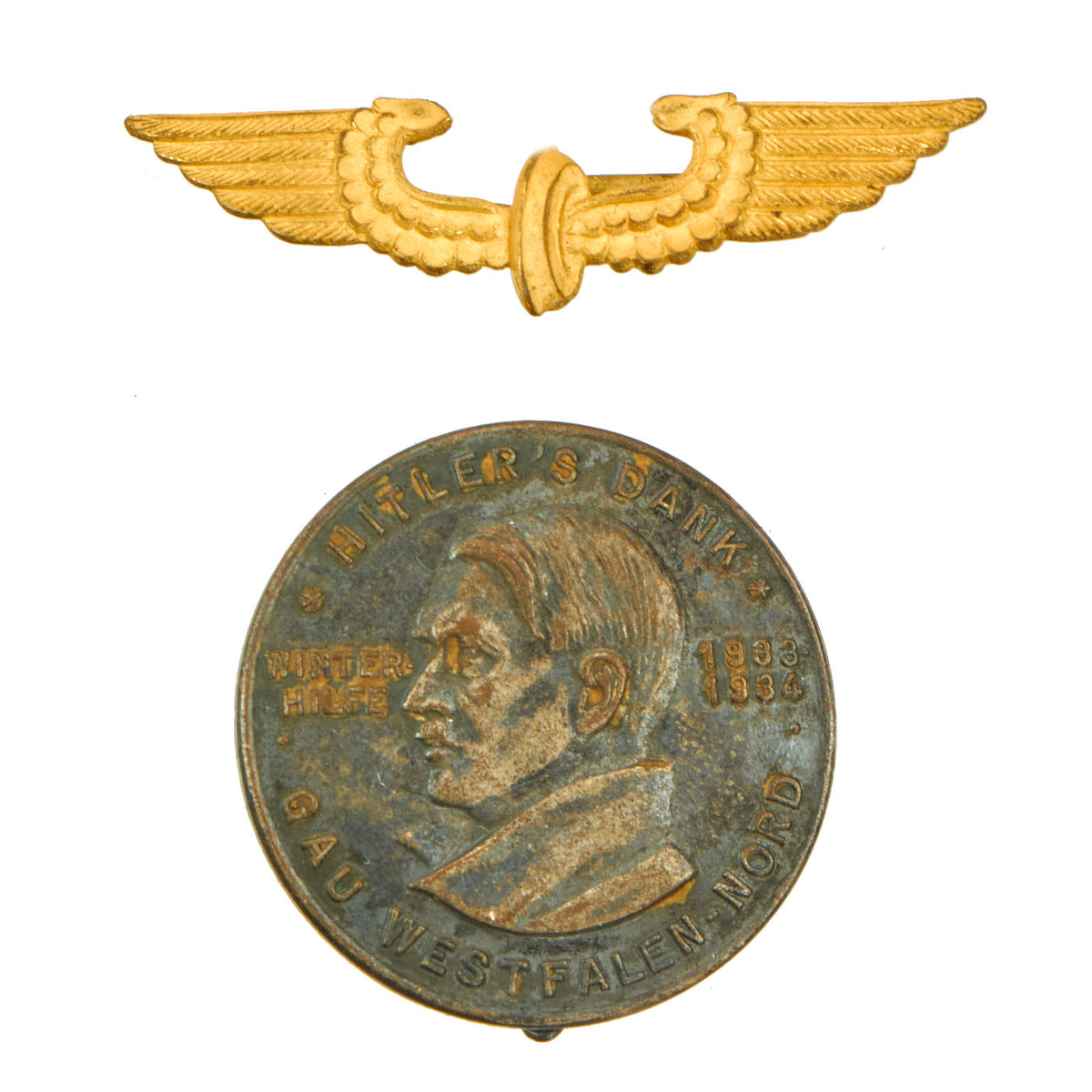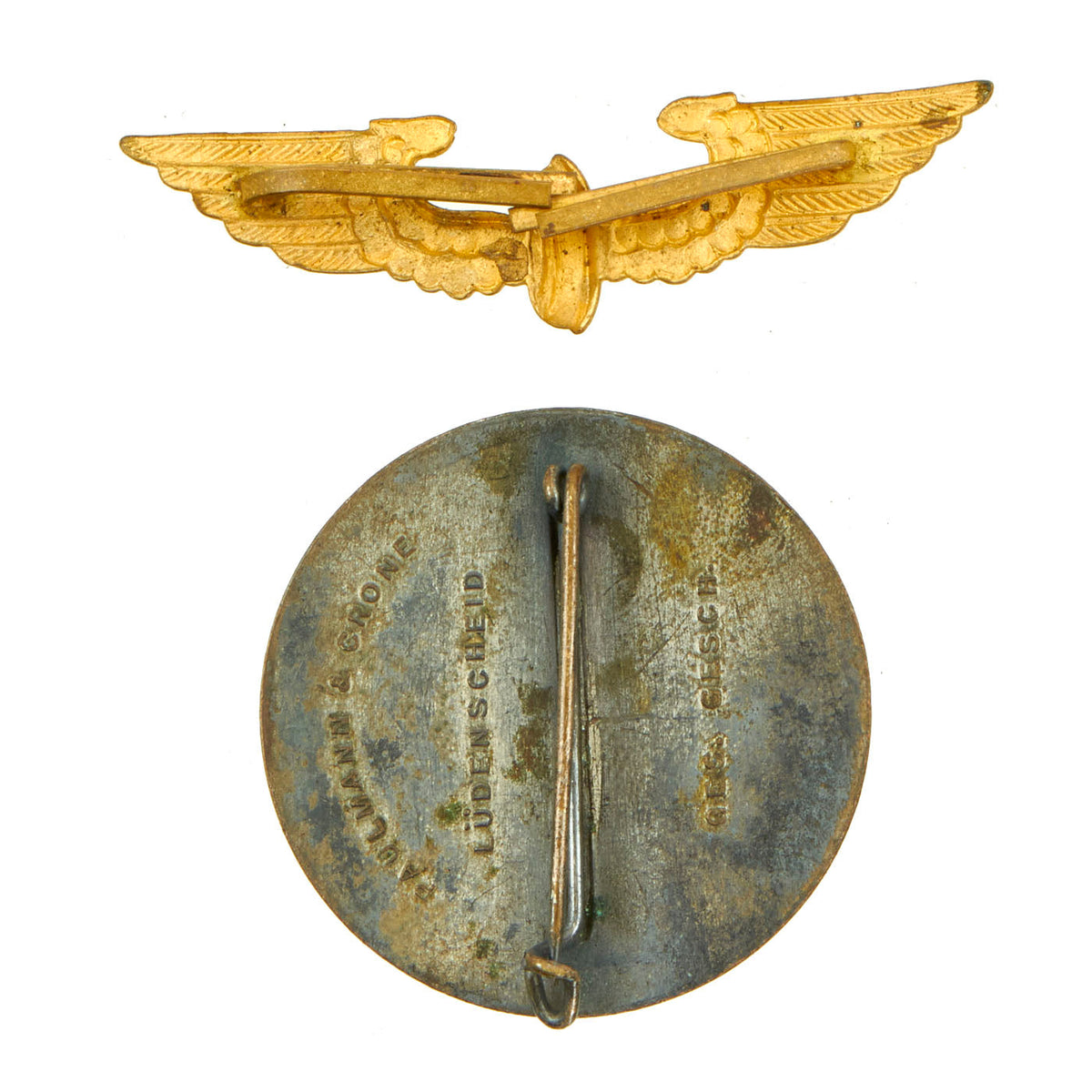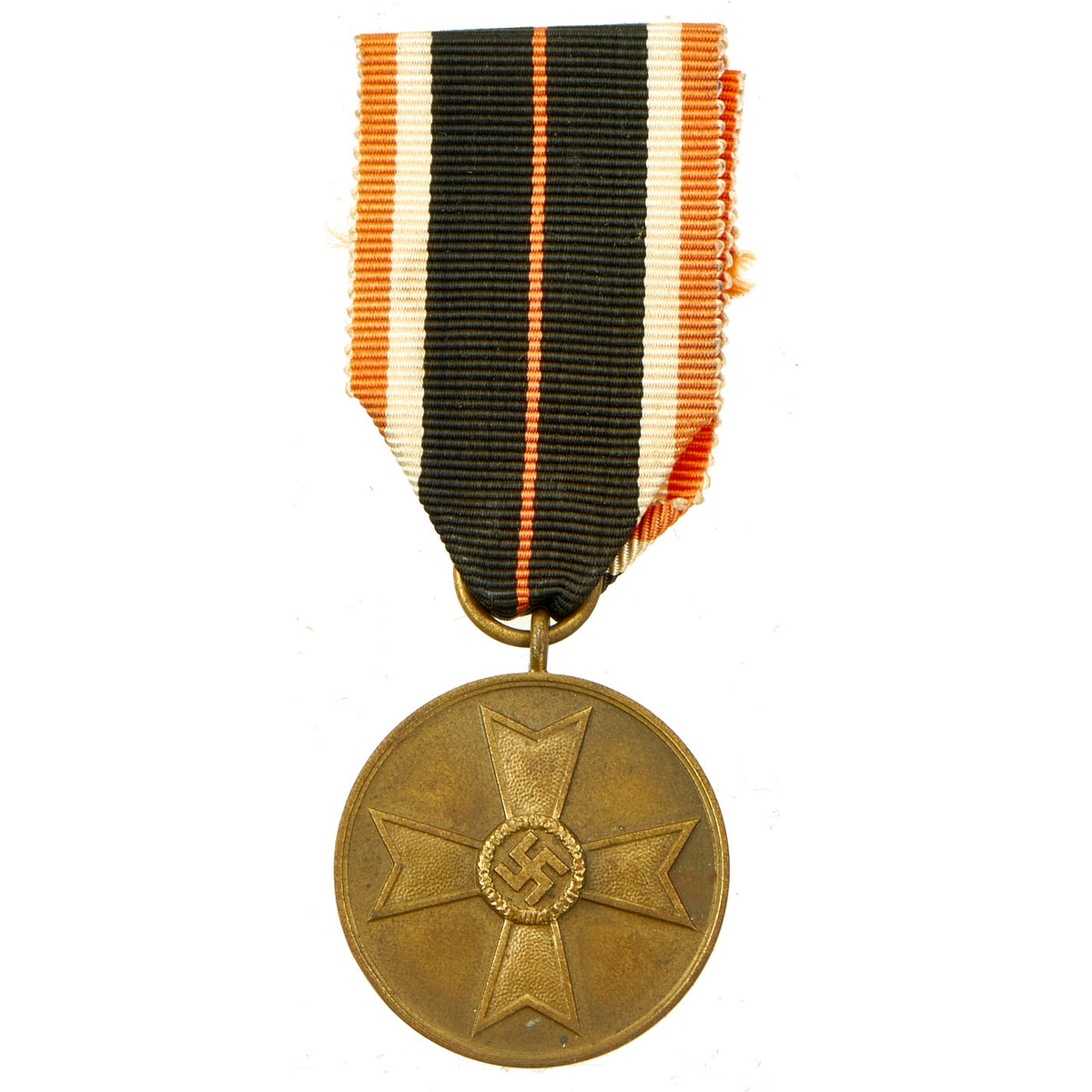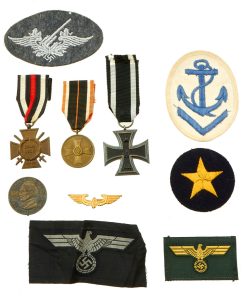Original German WWI & WWII Medal and Insignia Lot Featuring 1914 EK2 – 10 Items Original Items
$ 295,00 $ 118,00
Original Items: Only One Lot of 10 Available. This is a wonderful lot of items which were more than likely brought home by American soldiers at the end of both World Wars. They are in lovely condition and are perfect for the young collector who is looking to add a variety of medals and insignia to bolster their collections!
The Following Items Are Included:
World War 1 Items:
– Imperial German WWI Prussian Iron Cross Second Class 1914 with Ribbon: The basic design of the WWI crosses is a central cross patee struck from iron and mounted in a silver frame which has a raised crenulated decorative border. The obverse of the cross bears the date 1914 under a crowned W monogram. The reverse bears an oak leaf cluster in the center, with the date of the decoration’s institution 1813 underneath, and the crowned FW initials of Frederick William on the top arm above the oak leaf cluster. Suspension for second-class (EK II) types is by means of a ring, and frequently this ring bears a maker’s stamp. There is a mark on the ring, but we cannot tell if it is just a scratch, or a maker marking. This example still has the original black and white ribbon, which is still very crisp and clean.
– German WWI Honor Cross of the World War 1914/1918 (Hindenburg Cross) Medal: The medal features Crossed Swords and is attached to the correct ribbon. Maker marked 0.2 on the back. Unissued condition.
World War 2 Items:
– German WWII 1939 War Merit Medal (Kriegsverdienstmedaille): Comes complete with the original ribbon, in very good condition. There is a bit of oxidation on the back, but it has only caused discoloration.
– German WWII 1933-34 AH Dank “Thanks” WHW Donation Tinnie
– German WWII Railway Police Cap Badge: Bahnschutzpolizei (BSP) (Railway Protection Police) in NSDAP Germany was made up of full-time and part-time police officers who were employees of the Reichsbahn (state railways). The Bahnschutzpolizei was tasked with railway safety and also with preventing espionage and sabotage of railway property. It was not subordinated to Hauptamt Ordnungspolizei, only the Deutsche Reichsbahn.
– German WWII Senior Boatswain NCO’s Career Sleeve Insignia: On entering Kriegsmarine service all personnel were assigned and trained for a specific career. These careers consisted of a wide variety of specialty trades and functions with some of the careers restricted to certain rank groups. On successful completion of the appropriate training, personnel were issued distinctive career insignia to be worn on the upper left sleeve of the uniforms. For EM/NCO’s the career insignia could be worn combined with the rank insignia or as separate insignia. Enlisted ranks of Matrose up to and including Hauptgefreiter career insignia were generally embroidered on small round bases while NCO ranks of Maat up to and including Oberdeckoffizier career insignia were on larger, vertically oval bases and could come in embroidered or stamped alloy versions. Regulations dictated that the base color of the insignia was to match the color of the uniform it was worn on. Of Note: Rank designations were tied to the career the individual was assigned to and in this case the proper rank designation is Oberbootsmannsmaat. The insignia consists of a vertically oval brushed white cotton/rayon blend material base with a machine embroidered, vertical, fouled anchor position above a single, machine embroidered chevron all in cornflower blue cotton threads.
– German WWII Unissed Boatswain EM’s Career Sleeve Insignia: The insignia consists of a roughly 60mm diameter, navy blue wool base with a machine embroidered, five point star in bright, golden yellow, cotton threads.
– German WWII Unissued Luftwaffe Flak Artillery Trade Badge: On entering Luftwaffe, (Air-Force), service EM/NCO personnel were assigned and trained for a specific trade or military function. On successful completion of the appropriate training, personnel were issued a distinctive trade specialty badge to be worn on the lower left sleeve of the service tunic and the flight and field blouses as identifying insignia with a couple of exceptions. The original trade badges were introduced in May 1935 and were supplemented with additional badges prior to and early in the war. In all the Luftwaffe utilized no fewer than thirty-nine assorted trade specialty badges. Some select trade badges were piped with twisted, grey or silver/aluminum braiding to denote NCO’s ranks while some were piped with twisted, gilt braiding to denote outstanding performance in the particular trade. When a trade badge was allocated with the outstanding performance, gilt braid, piping it came accompanied with an award certificate. The first pattern Flakartillerie, (Anti-Aircraft Artillery), trade badge was originally introduced on October 28TH 1936 and consisted of a circular base with the likeness of a heavy artillery gun barrel, but that was replaced with a second pattern on July 23RD 1937. Requirement criteria for award of the badge indicated the personnel must have served at least nine months in a flak unit. The second pattern, (Circa 1937-1945), badge consists of a Luftwaffe blue/grey wool base with a machine embroidered likeness of a large 88mm flak gun barrel flanked by stylized wings, superimposed on an opened top, oak-leaf wreath with a canted swas to the bottom center all in silvery/gray rayon threads.
– German WWII Panzer EM/NCO’s M39 Breast Eagle: The German army originally adopted a slightly modified version of the NSDAP’s, Nationalsozialistische Deutsche Arbeiterpartei, (National Socialist German Workers Party), national eagle by order on February 17TH 1934, with instructions to have it applied to all steel helmets, visor caps, and tunics by May 1ST 1934. Later amendments to the introductory order stipulated that the national eagle was also to be worn on all field caps, the sports uniform and the black panzer wrap tunic. The eagle came in three distinct designs with two having slightly different, out-stretched wings and the third with down-swept wings. Generally officer’s ranks utilized hand or machine embroidered breast eagles while EM/NCO’s ranks utilized machine embroidered or machine woven breast eagles. During the war the breast eagles were manufactured in a variety of slightly different manufacturing techniques and colorations. The early standard issue EM/NCO’s M36 breast eagles were in white threads and were to be abolished in 1939 to be replaced with a less visible, grey, M39 breast eagle but the changeover was never fully completed. The early produced M36 and M39 breast eagles were mounted on a dark blue/green base while later production models were on a field-grey base. Both the M36 and the M39 breast eagles were intended for wear on the combat field blouse. Of Note: Panzer versions of the breast eagle were on a black base to match the black panzer wrap uniform. This is a later, M39 pattern, machine woven, national breast eagle with outstretched wings, clutching a wreathed, canted, swas in it’s talons in matte grey rayon threads on a woven, black, rayon base. The eagle is still on its original, black, rayon factory roll.
– German WWII Kriegsmarine Artillery EM/NCO’s M43 Cap Eagle: Machine woven cap eagle with out-stretched wings, clutching a wreathed, canted, swas in it’s talons, in bright, golden yellow rayon threads on a woven, dark blue/green, rayon base. Near mint.
A wonderful assortment of WWI and WWII German items that come more than ready for display.
Fast Shipping with Professional Packaging
Thanks to our longstanding association with UPS FedEx DHL, and other major international carriers, we are able to provide a range of shipping options. Our warehouse staff is expertly trained and will wrap your products according to our exact and precise specifications. Prior to shipping, your goods will be thoroughly examined and securely secured. We ship to thousands clients each day across multiple countries. This shows how we're dedicated to be the largest retailer on the internet. Warehouses and distribution centres can be located throughout Europe as well as the USA.
Note: Orders with more than one item will be assigned a processing date depending on the item.
Before shipping before shipping, we'll conduct a thorough inspection of the items you have ordered. Today, the majority of orders will be delivered within 48 hours. The delivery time will be between 3-7 days.
Returns
The stock is dynamic and we cannot completely manage it because multiple stakeholders are involved, including our factory and warehouse. So the actual stock may alter at any time. It's possible that you may not receive your order once the order has been made.
Our policy is valid for a period of 30 days. If you don't receive the product within 30 days, we are not able to issue a refund or an exchange.
You can only return an item if it is unused and in the same state as the day you received it. You must have the item in its original packaging.
Related products
Uncategorized
Uncategorized
Uncategorized
Uncategorized
Armoured Fighting Vehicles of the World: AFVs of World War One (Hardcover Book) New Made Items
Uncategorized
Uncategorized
Uncategorized
Uncategorized
Uncategorized
Uncategorized
Band of Brothers ORIGINAL GERMAN WWII Le. F.H. 18 10.5cm ARTILLERY PIECE Original Items
Uncategorized
Uncategorized
Uncategorized
Armored Burgonet Helmet & Polearm from Scottish Castle Leith Hall Circa 1700 Original Items
Uncategorized
Uncategorized
Uncategorized
Australian WWII Owen MK1 Machine Carbine SMG Custom Fabricated Replica with Sling Original Items
Uncategorized
Uncategorized
Uncategorized
Uncategorized
